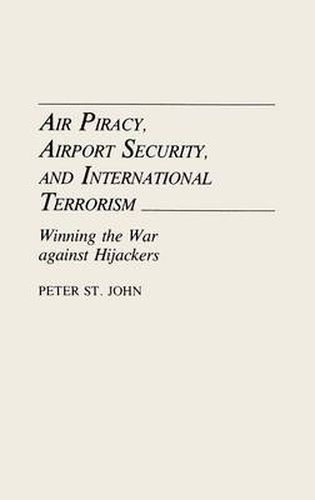Readings Newsletter
Become a Readings Member to make your shopping experience even easier.
Sign in or sign up for free!
You’re not far away from qualifying for FREE standard shipping within Australia
You’ve qualified for FREE standard shipping within Australia
The cart is loading…






As international terrorism has grown over the past decades, airlines and airports have become increasingly popular targets for violent attacks and hijackings. In this volume, Peter St John provides a survey of international air piracy and airline terrorism, and of the ways airline professionals and governments are coping, or trying to cope, with the crisis. He not only deals with the history, politics, psychology and sociology of air piracy, but also provides an assessment of the threat to commercial aircraft and ways to counter the danger. The pricipal theme he develops is that security for airports and aircraft can be achieved, and the fear of terrorists overcome, if western countries co-operate in installing effective security policies and plans. St John begins his work with a history of the evolution of hijacking, tracing the five-to-seven-year cycles that seem to have emerged and the growth of the politically motivated hijacking that has become one of the most persistent and dangerous forms. He next analyzes eight types of individuals who have hijacked aircraft in the past, their different motives and how they can be identified by airport security and flight crews. A major chapter discusses the politics of western governments toward hijacking in Europe and North America and identifies the best and worst airports around the globe. A seven-stage system of security is also proposed. Ensuing chapters address the problem of the hijacked plane, offering advice for passengers and crew members who are victims of hijacking and for government behaviour, which, the author argues, often does more to encourage air terrorism than to prevent it. Finally, St John looks at the future of airport security and describes the need for a concentrated attempt at all levels of national and international government to develop effective defences against air piracy. A group of appendices is also included, documenting the principal hijacks of the past 40 years as well as sabotage attempts on commercial aircraft.
$9.00 standard shipping within Australia
FREE standard shipping within Australia for orders over $100.00
Express & International shipping calculated at checkout
Stock availability can be subject to change without notice. We recommend calling the shop or contacting our online team to check availability of low stock items. Please see our Shopping Online page for more details.
As international terrorism has grown over the past decades, airlines and airports have become increasingly popular targets for violent attacks and hijackings. In this volume, Peter St John provides a survey of international air piracy and airline terrorism, and of the ways airline professionals and governments are coping, or trying to cope, with the crisis. He not only deals with the history, politics, psychology and sociology of air piracy, but also provides an assessment of the threat to commercial aircraft and ways to counter the danger. The pricipal theme he develops is that security for airports and aircraft can be achieved, and the fear of terrorists overcome, if western countries co-operate in installing effective security policies and plans. St John begins his work with a history of the evolution of hijacking, tracing the five-to-seven-year cycles that seem to have emerged and the growth of the politically motivated hijacking that has become one of the most persistent and dangerous forms. He next analyzes eight types of individuals who have hijacked aircraft in the past, their different motives and how they can be identified by airport security and flight crews. A major chapter discusses the politics of western governments toward hijacking in Europe and North America and identifies the best and worst airports around the globe. A seven-stage system of security is also proposed. Ensuing chapters address the problem of the hijacked plane, offering advice for passengers and crew members who are victims of hijacking and for government behaviour, which, the author argues, often does more to encourage air terrorism than to prevent it. Finally, St John looks at the future of airport security and describes the need for a concentrated attempt at all levels of national and international government to develop effective defences against air piracy. A group of appendices is also included, documenting the principal hijacks of the past 40 years as well as sabotage attempts on commercial aircraft.